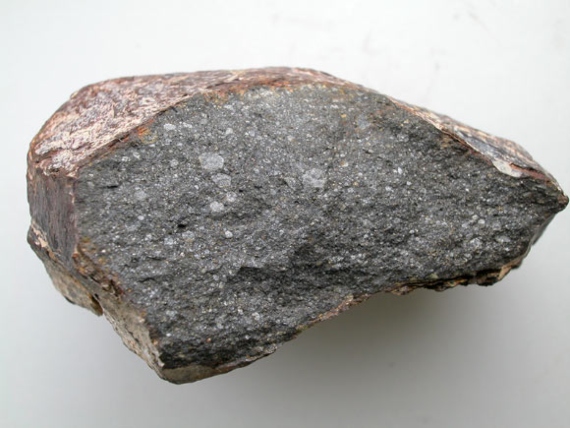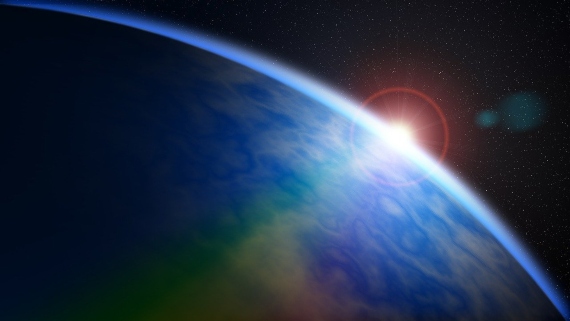In the creation myths of many cultures —from ancient Mesopotamia to the Book of Genesis, from the Inuit of the frozen north to the Kuba people of the Congo— the world began with the formless primordial waters, often associated with chaos and disorder, from which dry land, order and life emerge, with the helping hand of a creator god. Yet these stories never trouble themselves with explaining the origin of this mythical primeval water itself.
Modern planetary scientists, however, seek to explain the physical origin of Earth’s water, and propose ice-laden comets and asteroids as the source of the planet’s abundant supply of water. However, a new study published in Science that analysed the composition of a rare type of meteorite suggests that much of our water may have been present in the building blocks of the planet since its inception.
Water world
Viewed from space, the blue oceans of our planet are the dominant feature, covering more than 70% of the Earth’s surface. All together there is some 1.386 billion km3 of surface water or ice, which may sound like a lot but when compared to the size of the Earth can look rather insignificant.

The interior of the Earth, including the mantle and core, is also thought to contain huge quantities of water, perhaps many oceans worth. This water may act as a sort of lubricant for plate tectonics, one of the keys to life on Earth as it recycles carbon dioxide via volcanos and keeps our planet warm. There is also evidence that water exists in the interior of both the Moon and Mars. So where did all this water come from?
Rocky beginnings
Our world, along with the other rocky planets of Mercury, Venus and Mars, formed in the inner solar system, near the Sun, condensing out of swirling clouds of dust and gas through a process known as accretion. In this region of space it is too hot for ice or water to be stable, evidence of which can be observed in the tail and coma of comets, which appear when these “dirty snowballs” make their way into the inner solar system and begin to heat up dramatically.
If Earth was born a hot and dry planet, the water must have arrived later, after the planet had cooled, presumably brought by icy comets and asteroids from far out in the solar system, which bombarded the young planet, seeding it with their water, some of which stayed on the surface and became our oceans, while the rest made its way down into the mantle.

While this long-held theory does make sense, measurements made of the deuterium/hydrogen ratio in the water from various comets, including those made by ESA’s Rosetta spacecraft in 2014, have shown that comet water often contains significantly more deuterium than water found on Earth, ruling out these cosmic voyagers as the primary source of our water.
Asteroids, on the other hand, have proved to be a better match to the isotopic flavour of Earth’s oceans, but their small size and water load means that an enormous number of impacts would be required to account for all the water on Earth. The grand tack hypothesis, which posits that Jupiter ploughed through the asteroid belt early in the history of the solar system, has been suggested as one explanation for some of these supposed asteroid collisions.
In recent years, the idea has gained ground that perhaps much of Earth’s water is homegrown and formed during the process of planetary formation. Planetary scientists use hydrogen as a proxy for water content; because water molecules (H2O) are composed of oxygen and hydrogen atoms, and given that oxygen is abundant in the crust and mantle of our planet, finding hydrogen in the building blocks of Earth is akin to finding water. However, as hydrogen is the lightest gas, scientists had long assumed it would not be found in planetary material that formed in the inner solar system close to the Sun.
Hydrogen hunters
Laurette Piani, a cosmochemist at the University of Lorraine in Nancy, France, led a team of researchers that set out to look for hydrogen in material similar to that which formed the early Earth. They analysed a very rare type of meteorite called an enstatite chondrite (EC), as these have a similar isotopic composition to terrestrial rocks. Piani explained to OpenMind that, “we don’t know exactly where enstatite chondrites formed, but their chemical and mineralogical composition let people think that they formed closer to the Sun than other chondrite types. They can be seen as remnants of the planetary material that was present in the inner solar system (where the rocky planets formed).”

Piani and her team carefully selected 13 pristine EC meteorites and “applied a special analytical procedure to avoid being biased by the input of terrestrial water,” says Piani. What they discovered was unexpected. According to the study they published in Science, “EC meteorites contain sufficient hydrogen to have delivered to Earth as least three times the mass of water in its oceans.” What is more, the isotopic composition of the hydrogen and nitrogen in the meteorites match those of the Earth’s mantle, indicating that much of the planet’s atmospheric nitrogen could also have come from this material.
While the deuterium/hydrogen ratio of the EC meteorites analysed was a close match to the water in the Earth’s interior, it did not fit as well with ocean water, leaving the door open to the idea that collisions from comets and asteroids may also have enriched the planet’s water supply.
Profound implications for alien life
The implications of this discovery that hydrogen-bearing material was present in the inner solar system at the time of Earth’s formation are far reaching. As Piani tells OpenMind, “this material (or material that similarly contains hydrogen) would thus have also been present for the formation of the other rocky planets (and possibly also similarly in other stellar systems).” In fact, scientists believe that Venus may once have had a liquid ocean, a hypothesis supported by this study. And if, as Piani suggests, these findings can be extrapolated to other star systems, it means that ocean planets orbiting in the Goldilocks zone around other stars may abound in the universe, boosting the likelihood of there being other life in the cosmos.

It would thus seem that perhaps the creation myths had the right idea all along. The story of our world may not be one in which the primordial waters fell from the sky in some violent cosmic hailstorm from deep space that inundated our parched planet. Rather, the seeds of our oceans could have been present within the very building blocks of our embryonic planet itself, waiting only for the molten crust to cool enough for liquid water to seep up from the interior and pool on the surface, eventually covering much of the planet and providing suitable conditions for the appearance of life, for order to emerge from disorder.
Comments on this publication